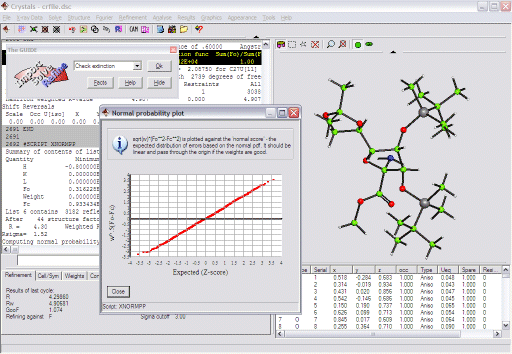chem cryst
CRYSTALS Software
University of Oxford
-Crystals
+ Research
Contact
Lectures
+ Links
+ Gallery
CSD installation
Chemistry Dept
Division
University of Oxford
chem cryst news
4 July 2004: CRYSTALS from Oxford
The Oxford X-ray crystallographic structure analysis software CRYSTALS is being distributed from our website at an ever increasing rate, which has now risen to more than 6000 downloads a year.
The program, based on an original idea of Rollett & Prout, has been developed in Oxford since the early 1970's. Very many authors, including some outside of Oxford, have contributed to the wealth of facilities now included in the program. For many years it was regarded as suitable only for use by experts working on difficult problems. In the end of the 1980's, VAX-VMS versions were being distributed on TK50 cassette tapes at the rate of only ten copies per year.
In 1995 Richard Cooper joined us as a Part II student. This one-year project was to look into the feasibility of adding a modern graphical user interface to CRYSTALS in order to make its features accessible to less expert users. The pilot project was so successful that Richard stayed on to work for a DPhil involving fundamental crystallography in parallel with developing a new GUI. This work marked the beginning of the way CRYSTALS was seen by the wider community, and largely accounts for its growing success. One consequence of this growing user community is that we are now regularly being invited to run CRYSTALS workshops.

The CRYSTALS user interface: analysis of
results
The key core features of CRYSTALS include: import of many data formats including .ins/.hkl files; automatic hydrogen atom placement; sophisticated least-squares refinement with constraints and restraints; many reflection weighting schemes; refinement of up to nine twin components and discovery of missed twin-laws using the ROTAX procedure; flexible fourier maps with many coefficients and output options (contour, MCE3D, map view and plain-text figure fields); Acta Cryst friendly CIF output and publication tables; powerful structural parameter editor.
CRYSTALS also includes an interpreter for its own programming language, SCRIPTS. These programs, together with the user interface provide many more powerful features including: built-in guidance and validation throughout the whole structure analysis; an interactive 3D graphical model of the structure; graphical analysis of data, results and residuals; simple dialog boxes to access most routines (e.g. Fourier maps, twin laws, data import and export, etc.) The software is distributed for free to non-for-profit organisations from our website http://www.xtl.ox.ac.uk/download.html.
[Comments | Download news]

